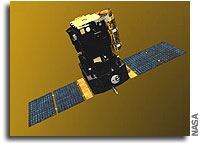SOHO Experiences High Gain Antenna Problem

After a spacecraft offpoint maneuver late on the morning of June 18 confirmed that the high gain antenna (HGA) had in fact not moved more than a small amount (in comparison to the steps commanded) since the first offpoint on June 4, we decided to switch to the redundant HGA electronics.
The FOT did so at approximately 19:30 UT, and we commanded an HGA motion about the spacecraft Z axis (i.e., east-west antenna motion) of roughly one degree. Less than one-fifth of that motion took place, as determined from automatic gain control readings at the ground station. We commanded another 131 steps, without any noticable antenna movement.
The similarity of the behavior on both the A and B sides indicates the likelihood of a mechanical problem with the antenna drive motor or mechanisms.
We held a teleconference with the manufacturer of the motor (Moog) and, following their recommendation, tried to command the antenna in high speed (100 Hz instead of 0.1 Hz) in both directions, without success.
During the night we will increase the temperature of the motor. Tomorrow we will repeat the same back and forth movement hoping to unstick the HGA.
If we are unable to drive the antenna any further back toward the center of its E-W range, we will probably lose high-rate (i.e., scientific) telemetry this weekend or early next week. The spacecraft will continue to maintain contact in low rate via the low-gain antenna.
The HGA east-west angle is near the “sweet spot” that would allow maximum coverage of the ± 25° range of the spacecraft orbit’s major axis, with some data loss (perhaps one month out of three) if we roll the spacecraft by 180° once every ~ three months. (The 3 db half-width of the antenna beam is about 7°.) With the help of the NASA Flight Dynamics Facility, we are also exploring the feasibility of changing the orbit in order to optimize the coverage period of the HGA.
The PI teams will be safing their instruments for an off-time of 4-6 weeks.








